This article was first published 12 years ago
Home »
Movies » Behind Life of Pi's GORGEOUS visuals effects
Behind Life of Pi's GORGEOUS visuals effects
Last updated on: March 13, 2013 19:08 IST
Image: A scene from Life of Pi
Life of Pi won an Oscar this year for Best Visual Effects, which went to the team of Bill Westenhofer, Guillaume Rocheron, Erik-Jan De Boer and Donald R Elliott of Rhythm and Hues, the people behind the film's VFX.
The team speaks to Patcy N about their experience from its Mumbai office.
Christabel D'cruz is from the technical animation team that takes care of the muscles, fur and skin.
Richard Liao from animation deals with acting and movements of the character. Charles is from the composite department who compiles everything together and make it look real.
Sonia D'costa and Neh Jaiswal are the production coordinators.
About Rhythm and Hues
Rhythm and Hues was formed 27 years ago in the United States by six people, three of whom are still with the company-- John Hughes, Pauline Ts'o and Keith Goldfarb.
The company opened its Mumbai office 10 years ago. The first film they worked on was Daredevils (2003).
Rhythm and Hues in Los Angeles takes the job and distributes it to different offices all over the world. Since the work comes from LA, the Indian offices work on only foreign movies, but they do sometimes work on Indian commercials like for Alpenliebe and Big Babol.
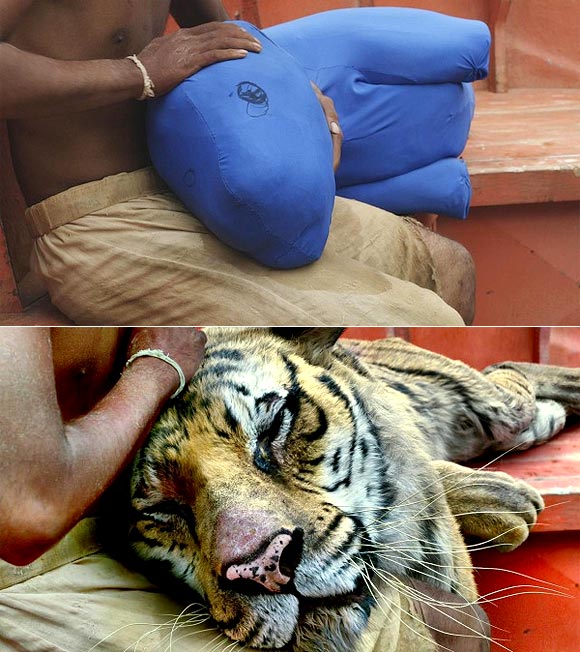
Image: A scene from Life of Pi before and after visual effects
The work was divided in such a way that, when Pi is with the tiger on the boat, that will go to one location, while the water scenes will go to another location and so on.
We did the mere (animals) and flying fish, and fish in the water which cannot be seen; we also animated the tiger here in Mumbai. To make the fish we modelled it on the computer in 3D.
Once the client tells us how the fish and tiger should look, it goes to the modelling department and based on the references, we use different software like Maya and create 3D models. Once the models are ready they are passed on to a different department.
The CG (Computer Graphic) boat was modelled in Mumbai and we textured it here. In some scenes the tiger was below the boat so we created that too and used wet cloth. All this was done with lighting and effects.
There is a scene where the tiger is on the lap of Pi. In that shot we used the stuffy (a stuffed animal). There is a department in 2D which removes the stuffy and replaces it with the tiger from the modelling department.
After that we do texturing and tech animation which takes care of the fur and hair of the tiger. Finally it should look so realistic that when Pi's hands are on the tiger, we have to show the fur in between Pi's fingers.
The model of the tiger goes to a process called rigging to make it alive, where we give it bone structure and basically make it like a puppet and the animators can move it around and make it act, like whether it needs to leap or whether it needs to lie still and breathe...everything is done on the computer.
Watch: The special effects of Life of Pi
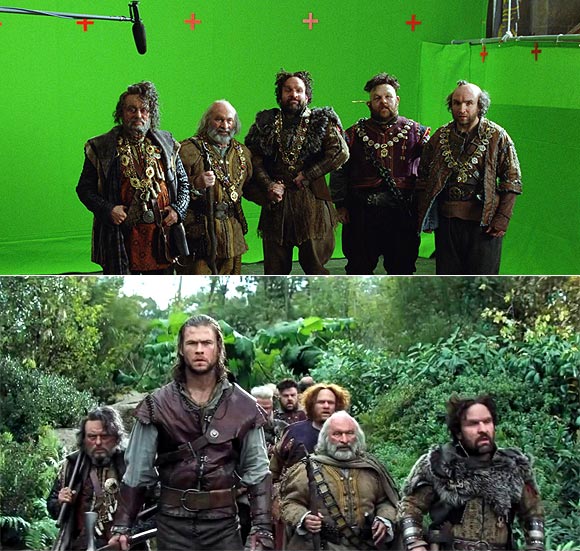
Image: A scene from Snow White and the Huntsman before and after visual effects
Creating the troll character in this film was quite a challenge, as the muscles were very differently set up. It was a very complex rig that we had to do. Every muscle fibre on the troll character was very difficult to do.
Since there was no reference, we were looking at human muscles and accordingly moving the muscle of the troll character. The troll looks a bit like a gorilla but it is very huge and looks somewhat like the bark of a tree, like it was growing in the forest for long.
The troll had to interact with the actress Kristen Stewart. The troll yells at her and pushes Kristen away. There was string attached to the actress so when the troll hits her, she had to swing, After the scene was shot we had to digitally remove the string.
Then there was a scene where the troll is hitting the water and walking on the water. The water needed to be generated on the computer and also the feel of water on him from dry to wet had to be done.
There were some scenes with dwarves so we had to shoot normal people and make them look like dwarves. When we do that, we don't just reduce the height, we have to work on each and every part—the face, neck, hands and legs.
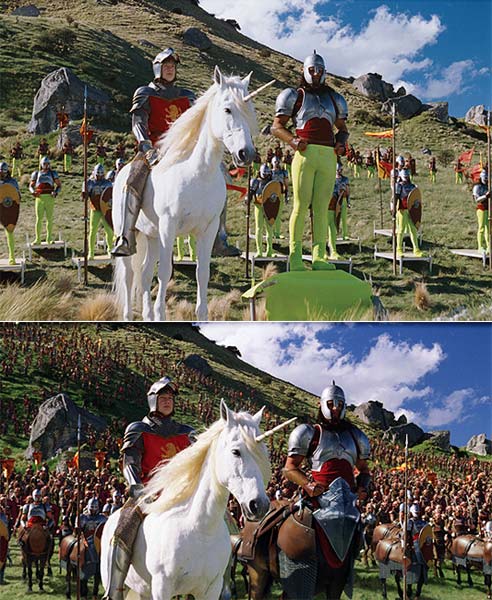
Image: A scene from The Chronicles of Narnia before and after visual effects
In Narnia it was the first time that a live actor was connected to a CG body of a horse, to create a character that is like the centaur (half man half horse).
We needed to figure out how the man's height needed to change according to the horse's height.
The actors were actually wearing green pants and they were standing on a height, on a little stool, sometimes platforms were created so it was elevated a little.
We did this for the rear of the horse and for the front, there was a real person who is actually running himself and acting as if he is a horse, and then that is matched in the computer so that the model actually fits into the live actor. They can then light it and composite it so that it looks seamless, it looks like a complete picture.
There are a few scenes where the centaur needs to speak, and it's the live actor who is part of the body of the centaur who speaks.
If there is a fight scene then we try to mostly replace digitally the whole character which would be computer generated and then they will be able to do all the actions and make the character fall, get hurt, or leap because shooting scene is not possible.
In
Narnia's war sequence, it looks like there are hundreds of characters, but in reality there were only two or three characters and the rest were replaced by us digitally.
Watch: The special effects of Life of Pi
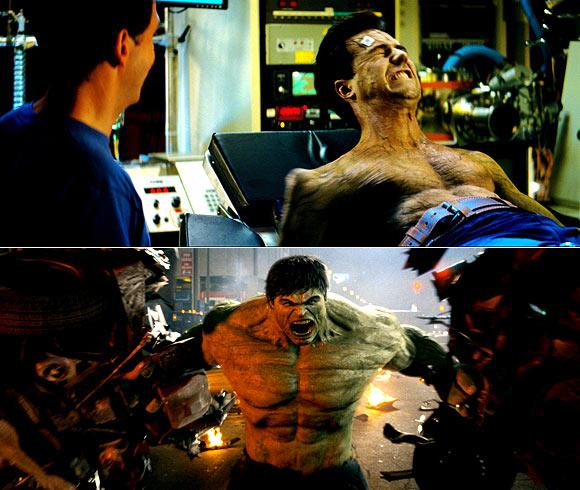
Image: A scene from Incredible Hulk before and after visual effects
In every Hulk movie there is a sequence where the actor becomes the Hulk.
It is very challenging to show the real actor turn into a CG character because the blend needs to be seamless. In Incredible Hulk, when Norton is tied down and he is being injected, he turns green and huge.
To do that, we actually track the actor's whole body by putting some points on the actor's body and replace it with a CG body of the live actor. Then we show the gradual growth from thin to huge of the CG character by morphing it as many times by the process of rigging.
We animate and make it look like one bone has grown out first and then the other bone starts growing. So we have to animate in such a way that it has to look like each part of the hulk's body grew out separately. We have to use blending so that it changes shape.
Also, it was difficult to make the city extension in the fight sequence. To create that city extension was difficult and after creating it, we have to destroy it too.
It takes time to create each element and to light it and make it look like an artistic image in the computer and when it is destroyed, it is destroyed in a way where it looks like a real structure is coming down and that structure doesn't exist any more. That is a challenge in itself as the rubble must look real, it cannot look like plastic.
Watch: The special effects of Life of Pi
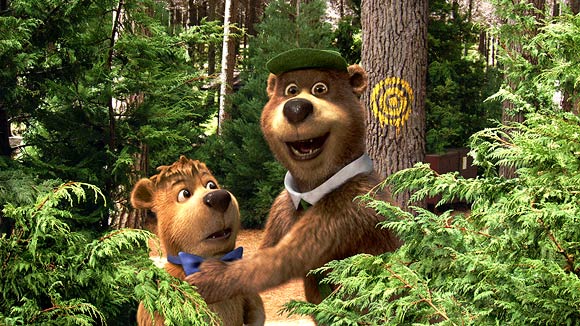
Image: A scene from Yogi Bear
Yogi Bear was our first stereo movie.
It was shot on two cameras, in such films you get glasses to watch the film in theatre. In Yogi Bear the challenge was getting the old tele-series that we had seen in our childhood, back again on the big screen.
Trying to replicate the same characteristic of Yogi Bear in a CG character was a little bit of a challenge.
Sometimes we fall in love with the characters that we make, especially characters like Yogi or Alvin from Alvin and the Chipmunks, or The Hulk. You want to keep working on them but eventually you have to let go.
Watch: The special effects of Life of Pi





